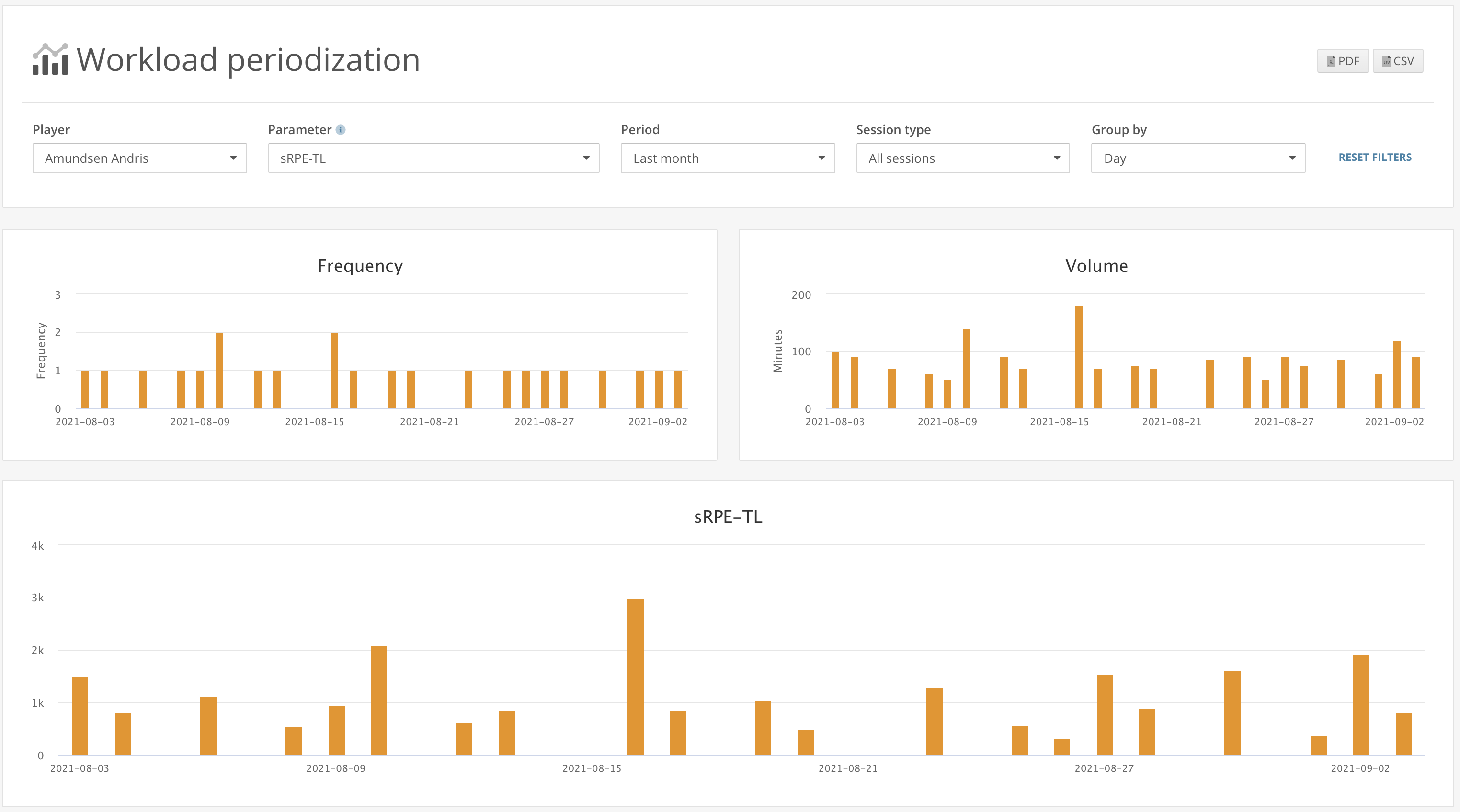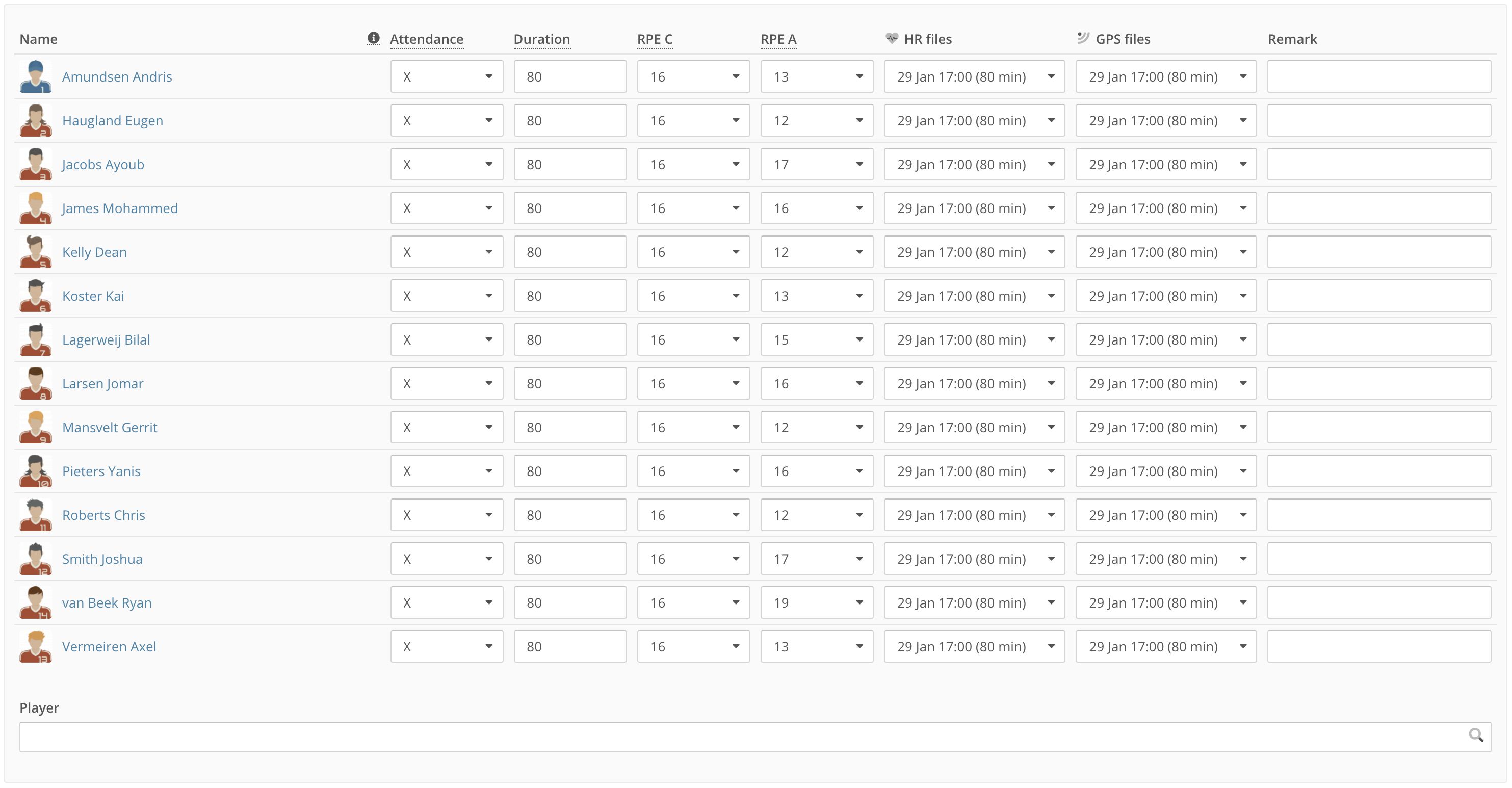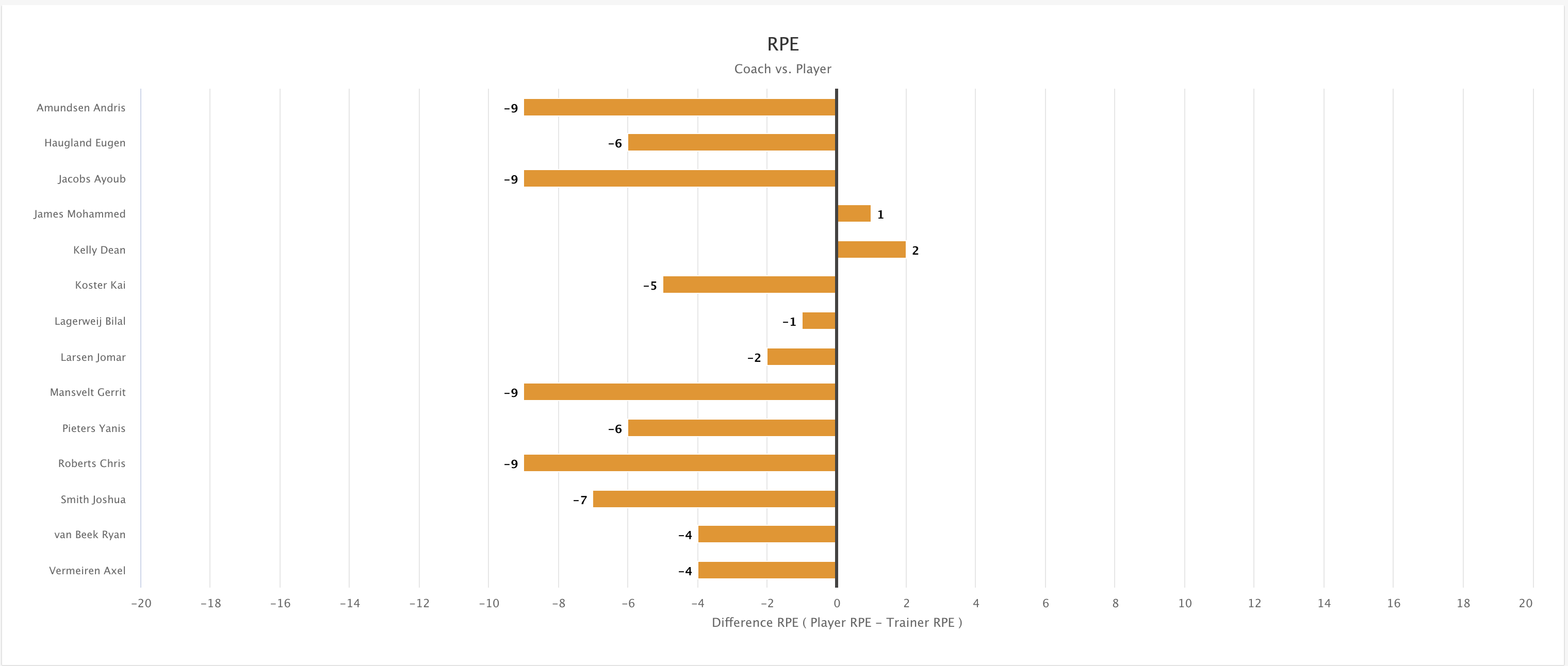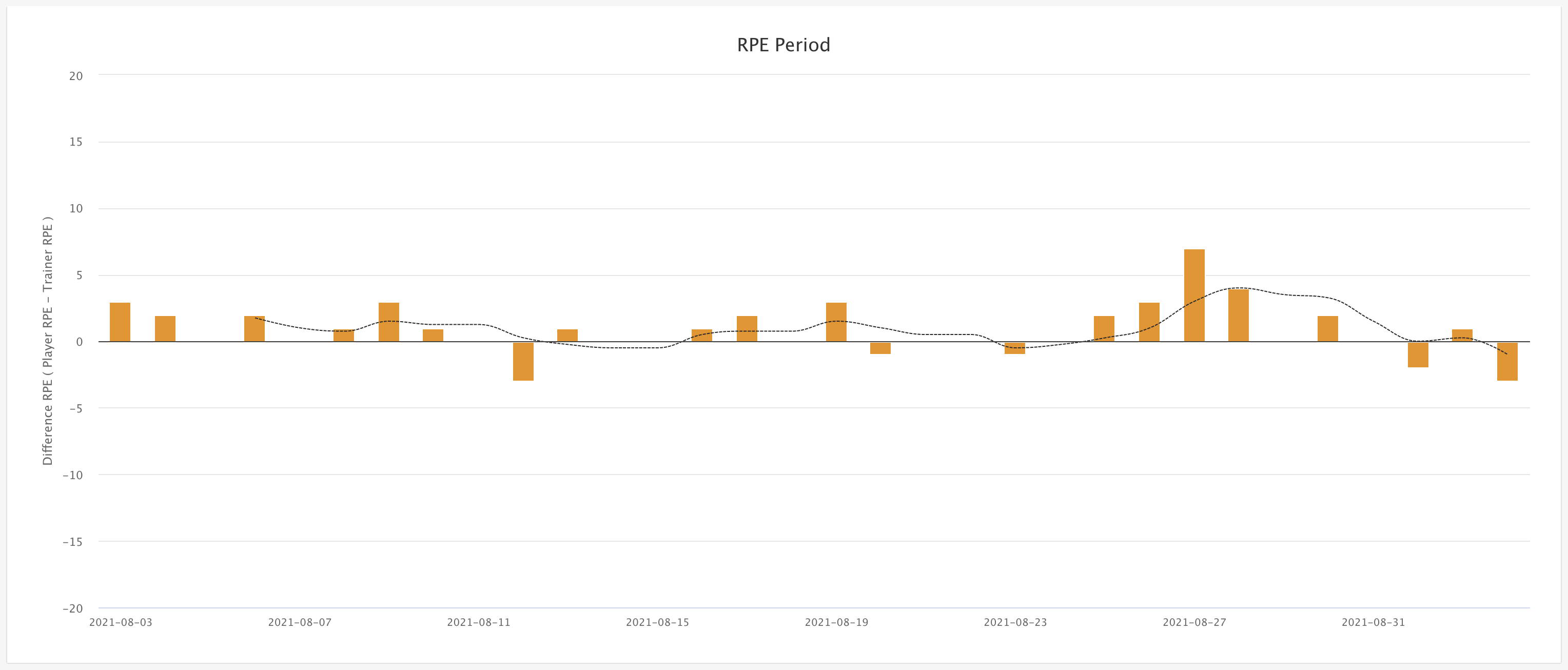Monitoring training load with Rating of Perceived Exertion (RPE)
RPE: A powerful tool for monitoring training load?
Why do we monitor training load in team sports?
To optimise players’ readiness to perform.
In team sports, individual or team success is mainly driven by players’ technical and tactical performances. Think about the dribbling skills of Messi or the solid defensive organisation by Bonucci and Chiellini.
As a coach, it is therefore important to field your best (combination of) players. This is of course not possible when players are injured and thus unavailable to compete. The effect of high injury rates on individual and team success is described by multiple studies. For example, a study in Australian Football showed that the impact of injury could explain up to 12% in the final table position.1 Another (very recent) study showed that the progression of elite youth football players to next age categories or the first team was negatively influenced by a low match availability.2
While some injuries are difficult to prevent (e.g., contact injuries), a considerable amount of injuries can be attributed to overuse mechanisms resulting from a misbalance between training load and recovery.3 Therefore, in addition to monitoring recovery, it is advised to monitor training load to evaluate if players’ exposure to training is in line with current training theory and methodology.4
Of course, being available to compete is only the first step to success. A major aim of load monitoring is therefore also to improve players physical attributes related to endurance, strength and speed. In this context, a systematic exposure to training load (and recovery) is required to foster positive training adaptations. Improving the fitness of players is not only important to achieve high performance outcomes during single matches, but is also required to perform consistently during prolonged seasonal periods.
Why do we monitor internal training load?
To evaluate individual players’ ability to cope with external load.
In the quantification of training load, a distinction is made between external and internal load, depending on whether the measured variable reflects an aspect of training load that occurs internally or externally to the player.5
External load variables are often quantified using electronic performance tracking systems (EPTS) such as global navigation satellite systems (GLONASS, GPS).6 Such systems typically yield variables related to the distance that players cover at various speeds or acceleration levels. These variables are often used to plan training.
In team sports, training is often organised on the group level. Therefore, the average difference in external load between players can be limited. However, every player responds differently to the external load based on his physical attributes.5
A player who is less fit will for example be more fatigued by a series of running bouts compared to a highly fit player.7 Therefore, it is important to monitor these individual responses to external load, which is known as the internal load.

The Topsportslab platform’s can help you easily monitor internal and external load by using the workload periodisation feature.
What is the rating of perceived exertion method (RPE)?
An indicator of the psychophysiological stress that players experience during training.
Different methods are available to monitor internal load. The most known method is the monitoring of heart rate, which provides an indication of the cardiorespiratory stress during exercise.8 Other methods, such as lactate measurements, are also used but are less practical for continuous monitoring in team sports.
A common method to understand the psychophysiological stress during exercise is to ask players about their perceived exertion (also called perceived effort).9 In scientific literature, perceived exertion is defined as the players’ conscious sensation of how hard and strenuous a physical task is.10
Since the mid-19th century, different scales are being developed to allow players to rate their perceived exertion (RPE) using numerical values (Figure 1).11 While such ratings can be collected during training, it is more common to ask players at the end of a session to rate their perceived exertion over the entire session.
This rating, known as the session rating of perceived exertion, reflects the average perceived psychophysiological stress of the entire session.
The validity and reliability of this method to monitor internal training load in team sports is investigated by multiple studies.12, 13 The main outcome of these studies is that RPE is highly associated with other internal load measures such as HR and also correlates with the external load derived from EPTS. These findings provide evidence for the usefulness of RPE to monitor training load in team sports.
| 6 | No exertion at all |
| 7 | Extremely light |
| 8 | |
| 9 | Very light |
| 10 | Light |
| 11 | |
| 12 | |
| 13 | Somewhat hard |
| 14 | Hard (heavy) |
| 15 | |
| 16 | |
| 17 | Very hard |
| 18 | |
| 19 | Extremely hard |
| 20 | Maximal exertion |

The Topsportslab platform can help you gain insights by comparing coach-intended and player-experienced RPE. These metrics can be set on every group training session.
Why do we compare coach-intended versus player-experienced RPE?
To evaluate potential mismatches between planned and actual training loads.
It is important that coaches are able to estimate the internal load when they plan future training. If a mismatch occurs between the coach-intended and the actual training load, coaches would run the danger of under- or overloading their players.
Therefore, it is useful for coaches to gain insight into how players perceive training and how this relates to their intended training goals.

A Dutch research group from the University of Groningen examined the discrepancy between coach-intended (RPE-C) and athlete- or player-experienced RPE values (RPE-A) in a cohort of elite youth football players (under-17 to under-19).14
Their main finding was that RPE-A was higher than RPE-C when the training sessions was thought to be ‘easy’, and RPE-C was higher than RPE-A when the session was aimed to be ‘hard’. Therefore, it seems that coaches tend to overestimate the effect of their training goal on the actual internal training load.
Monitoring and comparing RPE-C and RPE-A may thus be a good learning tool for coaches to better understand to which extent players perceive the psychophysiological stress during training as intended by the coaches’ own planning.
While this can be analysed on the team-level for certain training sessions, it may also be useful to detect possible within-player deviations over time which can provide useful information about how players are coping with training.
For example, a mismatch for a given player, such as a consistently higher RPE-A during a given period, may possibly indicate maladaptation to training.

Care to keep updated?
Subscribe to our newsletter.
You’ll get updates about our recent blog posts and platform updates.
Error: Contact form not found.
References
- Hoffman DT, Dwyer DB, Bowe SJ, Clifton P, Gastin PB. Is injury associated with team performance in elite Australian football? 20 years of player injury and team performance data that include measures of individual player value. Br J Sports Med. Apr 2020;54(8):475-479. doi:10.1136/bjsports-2018-100029
- Larruskain J, Lekue JA, Martin-Garetxana I, Barrio I, McCall A, Gil Sm. Injuries are negatively associated with player progression in an elite football academy. Sci Med Footb. doi:10.1080/24733938.2021.1943756
- Ekstrand J, Hagglund M, Walden M. Injury incidence and injury patterns in professional football: the UEFA injury study. Br J Sports Med. Jun 2011;45(7):553-8. doi:10.1136/bjsm.2009.060582
- Impellizzeri FM, Menaspa P, Coutts AJ, Kalkhoven J, Menaspa MJ. Training Load and Its Role in Injury Prevention, Part I: Back to the Future. J Athl Train. Sep 1 2020;55(9):885-892. doi:10.4085/1062-6050-500-19
- Impellizzeri FM, Marcora SM, Coutts AJ. Internal and External Training Load: 15 Years On. Int J Sports Physiol Perform. Feb 1 2019;14(2):270-273. doi:10.1123/ijspp.2018-0935
- Nosek PB, T. E.; Drust, B.; Andrew, M. . Feedback of GPS training data within professional English soccer: a comparison of decision making and perceptions between coaches, players and performance staff. Sci Med Footb. 2021;5(1):35-47. doi:10.1080/24733938.2020.1770320
- Krustrup P, Mohr M, Amstrup T, et al. The yo-yo intermittent recovery test: physiological response, reliability, and validity. Med Sci Sports Exerc. Apr 2003;35(4):697-705. doi:10.1249/01.MSS.0000058441.94520.32
- Schneider C, Hanakam F, Wiewelhove T, et al. Heart Rate Monitoring in Team Sports-A Conceptual Framework for Contextualizing Heart Rate Measures for Training and Recovery Prescription. Front Physiol. 2018;9:639. doi:10.3389/fphys.2018.00639
- Foster C, Boullosa D, McGuigan M, et al. 25 Years of Session Rating of Perceived Exertion: Historical Perspective and Development. Int J Sports Physiol Perform. Jan 28 2021:1-10. doi:10.1123/ijspp.2020-0599
- Halperin I, Emanuel A. Rating of Perceived Effort: Methodological Concerns and Future Directions. Sports Med. Apr 2020;50(4):679-687. doi:10.1007/s40279-019-01229-z
- McLaren SJ, Coutts AJ, Impellizzeri FM. Perception of effort and subjective monitoring. In: French DN, Torres Ronda L, eds. NSCA’s essentials of sport science. Human Kinetics; 2021:231-256:chap 17.
- McLaren SJ, Macpherson TW, Coutts AJ, Hurst C, Spears IR, Weston M. The Relationships Between Internal and External Measures of Training Load and Intensity in Team Sports: A Meta-Analysis. Sports Med. Mar 2018;48(3):641-658. doi:10.1007/s40279-017-0830-z
- Coutts AJ, Rampinini E, Marcora SM, Castagna C, Impellizzeri FM. Heart rate and blood lactate correlates of perceived exertion during small-sided soccer games. J Sci Med Sport. Jan 2009;12(1):79-84. doi:10.1016/j.jsams.2007.08.005
- Brink MS, Frencken WG, Jordet G, Lemmink KA. Coaches’ and players’ perceptions of training dose: not a perfect match. Int J Sports Physiol Perform. May 2014;9(3):497-502. doi:10.1123/ijspp.2013-0009